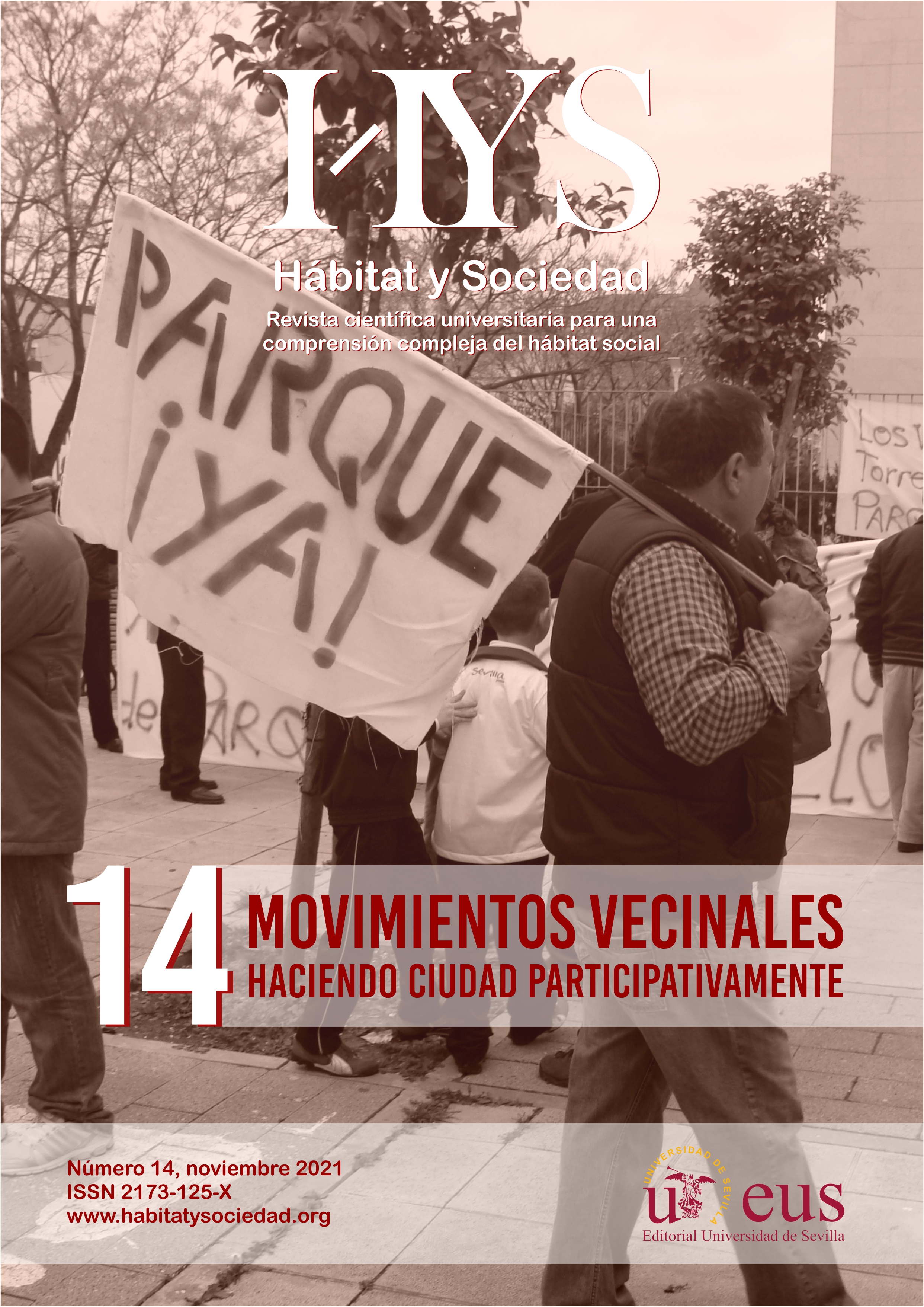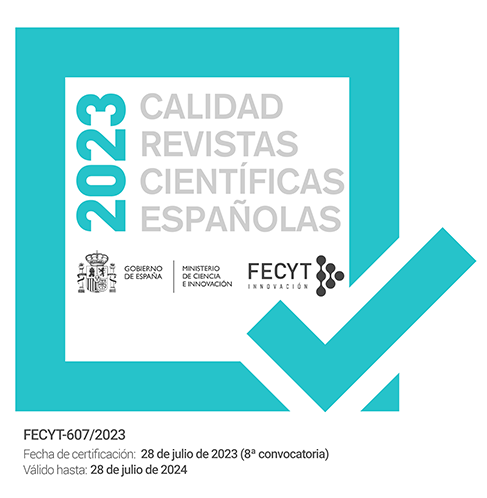Nature based Solutions: urban strategies for adaptation to climate change
DOI:
https://doi.org/10.12795/HabitatySociedad.2021.i14.13Keywords:
Ecosystems, Nature-Based Solutions, Cities, Adaptation, Climate ChangeAbstract
Cities will suffer the impacts of climate change in the next decades. These impacts will be different according to their geographical features, the distribution and number of green spaces, the characteristics of the exterior surfaces of their floors and the density of population, among other aspects.
Given this situation, many cities have begun to adopt adaptation strategies to reduce their vulnerability to the adverse effects of the climate; among which Nature-Based Solutions (NBS) stand out. Cities such as Barcelona and Portland are examples of how to intervene using different strategies with the aim of improving climate regulation, increasing biodiversity, becoming carbon sinks and improving people's quality of life.
The two areas of intervention of the NBSs - green infrastructures and biomimetic solution- have become intervention tools that, in addition to allowing cities to adapt to climate change, can be incorporated into local urban planning regulations through strategies that will also influence the global level.
Downloads
Metrics
References
Aanuoluwapo, O. O., & Ohis, A. C. (2017). Biomimetic Strategies for Climate Change Mitigation in the Built Environment. Energy Procedia, 105, 3868-3875. DOI: https://doi.org/10.1016/j.egypro.2017.03.792
Ajuntament de Barcelona (2013). Barcelona Green Infrastructure and Biodiversity Plan 2020. Barcelona: Medi Ambient i Serveis Urbans - Hàbitat Urbà. Ajuntament de Barcelona. Recuperado de 22 de junio de 2020 de https://ajuntament.barcelona.cat/ecologiaurbana/sites/default/files/Barcelona%20green%20infrastructure%20and%20biodiversity%20plan%202020.pdf
Ajuntament de Barcelona (2017). Árboles para vivir : plan director del arbolado de Barcelona 2017-2037. Barcelona: Área de Ecología Urbana. Ayuntamiento de Barcelona. Recuperado el 22 de junio de 2020 de https://ajuntament.barcelona.cat/ecologiaurbana/sites/default/files/Pla-director-arbrat-barcelona-CAST.pdf
Bauduceau, N., Berry, P., Cecchi, C., Elmqvist, T., Fernandez, M., Hartig, T., Krull, W., Mayerhofer, E., N, S., Noring, L., Raskin-Delisle, K., Roozen, E., Sutherland, W., & Tack, J. (2015). Towards an EU Research and Innovation Policy Agenda for Nature-based Solutions & Re-naturing Cities: Final Report of the Horizon 2020 Expert Group on 'Nature-based Solutions and Re-naturing Cities'. Publications Office of the European Union. DOI: https://doi.org/10.2777/765301
Eggermont, H., E. Balian, J. M.N. Azevedo, V. Beumer, T. Brodin, J. Claudet, B. Fady, M. Grube, H. Keune, P. Lamarque, K. Reuter, M. Smitt, C. Van Ham, W.W. Weisser & X. Le Roux (2015) Nature-based solutions: new influence for environmental management and research in Europe. GAIA Ecological Perspectives,24 (4), 243–248. DOI: https://doi.org/10.14512/gaia.24.4.9
Cohen-Shacham, E., Walters, G., Janzen, C., & Maginnis, S. (2016). Nature-based Solutions to address global societal challenges. Gland, Switzerland: IUCN. Xiii + 97 pp. DOI: https://doi.org/10.2305/IUCN.CH.2016.13.en
Comisión Europea y Agencia Europea de Medio Ambiente (2016). Barcelona trees tempering the Mediterranean city climate. Climate Adapt. Sharing adaptation information across Europe. Recuperado el 10 de junio de: https://climate-adapt.eea.europa.eu/metadata/case-studies/barcelona-trees-tempering-the-mediterranean-city-climate
Depietri, Y., Kallis, G., Baró, F., & Cattaneo, C. (2016). The urban political ecology of ecosystem services: The case of Barcelona. Ecological Economics, 125, 83-100. DOI: https://doi.org/10.1016/j.ecolecon.2016.03.003
European Commission (2014). Construir una infraestructura verde para Europa. Bruselas: Oficina de Publicaciones Unión Europea. Recuperado el 25 de junio de 2020 de https://ec.europa.eu/environment/nature/ecosystems/docs/GI-Brochure-210x210-ES-web.pdf
European Commission (2015). Towards an EU Research and Innovation policy agenda for Nature-Based Solutions & Re-Naturing Cities. Final Report of the Horizon, 2020. Luxemburgo: Oficina de Publicaciones Unión Europea. Recuparado el 25 de junio de 2020 de file:///D:/Descargas%20CHROME/KI0215162ENN_002%20(3).pdf
Frantzeskaki, N. (2019). Seven lessons for planning nature-based solutions in cities. Environmental science & policy, 93, 101-111. DOI: https://doi.org/10.1016/j.envsci.2018.12.033
Graham, P. (2003). Building Ecology. First Principles for a Sustainable Built Environment. Australia: John Wiley & Sons.
Hargroves, K. & Smith, M. (2006), "Innovation inspired by nature: Biomimicry", Ecos, 2006 (129), 27-29. DOI: https://dx.doi.org/10.1071/EC129p27
IPCC (Intergovernmental Panel on Climate Change) (2019).IPCC Special Report on Climate Change, Desertification, Land Degradation, Sustainable Land Management, Food Security, and Greenhouse Gas Fluxes in Terrestrial Ecosystems. Summary for Policy makers. IPCC. Recuperado el 20 de junio de 2020 de https://www.ipcc.ch/srccl/
IUCN (2012) Programa de la UICN 2013-2016. Recuperado el 20 de junio de https://www.iucn.org/es/content/el-programa-2013-2016-objetivos-claros-desafios-concretos
IUCN (2016) Resolution 069 World Conservation Congress 2016, Hawaii. Recuperado el 21 de junio de https://portals.iucn.org/library/sites/library/files/resrecfiles/WCC_2016_RES_069_ES.pdf
IUCN (2020).Guidance for using the IUCN Global Standard for Nature-based Solutions. A user-friendly framework for the verification, design and scaling up of Nature-based Solutions. First edition. Gland, Switzerland: IUCN. DOI: https://doi.org/10.2305/IUCN.CH.2020.09.en
Kabisch, N., Frantzeskaki, N., Pauleit, S., Naumann, S., Davis, M., Artmann, M., Haase, D., Knapp, S., Korn. H., Stadler, J., Zaunberger, K.,& Bonn, A. (2016). Nature-based Solutions to climate change mitigation and adaptation in urban areas: perspectives on indicators, knowledge gaps, barriers, and opportunities for action. Ecology and Society 21(2): 39. DOI: http://dx.doi.org/10.5751/ES-08373-210239
Künzli, N., & Perez, L. (2007). The public health benefits of reducing air pollution in the Barcelona metropolitan area. Deparment de Salud de la Generalitat de Catalunya and Department de Medi Ambient i Habitatge de la Generalitat de Catalunya. Recuperado el 30 de junio de 2020 de: https://www.researchgate.net/profile/Nino_Kuenzli/publication/242153263_The_public_health_benefits_of_reducing_air_pollution_in_the_Barcelona_metropolitan_area/links/0deec5337c89c45322000000/The-public-health-benefits-of-reducing-air-pollution-in-the-Barcelona-metropolitan-area.pdf
Laghai, H. A., & Bahmanpour, H. (2012). GIS application in urban green space per capita evaluation:(Case study: City of Tehran). Annals of Biological Research, 3(5), 2439-2446. Recuperado el 24 junio de 2020 de: https://www.scholarsresearchlibrary.com/articles/gis-application-in-urban-green-space-per-capita-evaluation-case-study-city-of-tehran.pdf
Mithun (2004).Proyecto Lloyd Crossing realizado en Portland (Oregon). Recuperado el 10 de junio de 2020 de: https://mithun.com/project/lloyd-crossing-sustainable-urban-design-plan/
Nesshöver, C., Assmuth, T., Irvine, K. N., Rusch, G. M., Waylen, K. A., Delbaere, B., Haase, D., Jones-Walters, L., Keune, H., Kovacs, E., Krauce, K., Külvik, M., Rey, F., Dijk, J., Vistad, O.I., Wilkinson, M.E., & Wittmer, H. (2017). The science, policy and practice of nature-based solutions: An interdisciplinary perspective. Science of the Total Environment, 579, 1215-1227. DOI: https://doi.org/10.1016/j.scitotenv.2016.11.106
Oltra, C., & Marín, R. (2013). Los retos en la adaptación al cambio climático en entornos urbanos. Papers: Revista de sociología, 98(2), 0311-330. DOI: http://dx.doi.org/10.5565/rev/papers/v98n2.498
Sarabi, S.E., Han, Q., L Romme, A. G., de Vries, B., & Wendling, L. (2019). Key enablers of and barriers to the up take and implementation of nature-based solutions in urban settings: a review. Resources, 8(3), 121. DOI: https://doi.org/10.3390/resources8030121
Verdaguer Viana-Cárdenas, C., Fariña-Tojo, J., Luxan-García de Diego, M. D., Gómez-Muñoz, G., Román-López, M. E., Velázquez-Valoria, I., & Sanz-Alduán, A. (2015). Medidas para la mitigación y la adaptación al cambio climático en el planeamiento urbano. Guía metodológica. Red Española de Ciudades por el Clima. Recuperado el 30 de junio de 2020 de: http://oa.upm.es/35571/7/FEMP_Medidas_CCC_Planeamiento_urbano.pdf
Zari, M. P. (2015). Can Biomimicry Be a Useful Tool for Design for Climate Change Adaptation and Mitigation? Biotechnologies and Biomimetics for Civil Engineering, 81-113. DOI: https://doi.org/10.1007/978-3-319-09287-4_4
Published
How to Cite
Issue
Section
License
Copyright (c) 2021 Raquel Rey Mellado, María Teresa Franchini Alonso, Cristina del Pozo Sánchez

This work is licensed under a Creative Commons Attribution-NonCommercial-NoDerivatives 4.0 International License.
Los autores/as que publiquen en esta revista aceptan las siguientes condiciones:
1. Los autores/as conservan los derechos de autor y ceden a la revista el derecho de la primera publicación, con el trabajo registrado con la licencia de atribución de Creative Commons, que permite a terceros utilizar lo publicado siempre que mencionen la autoría del trabajo y a la primera publicación en esta revista.
2. Los autores/as pueden realizar otros acuerdos contractuales independientes y adicionales para la distribución no exclusiva de la versión del artículo publicado en esta revista (p. ej., incluirlo en un repositorio institucional o publicarlo en un libro) siempre que indiquen claramente que el trabajo se publicó por primera vez en esta revista.
3. Se permite y recomienda a los autores/as a publicar su trabajo en Internet (por ejemplo en páginas institucionales o personales) antes y durante el proceso de revisión y publicación, ya que puede conducir a intercambios productivos y a una mayor y más rápida difusión del trabajo publicado (vea The Effect of Open Access).
Accepted 2021-08-05
Published 2021-11-02
- Abstract 1070
- pdf (Español (España)) 1374
- epub (Español (España)) 136












